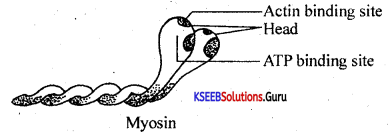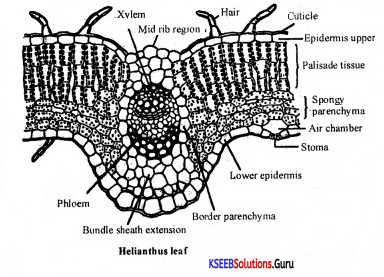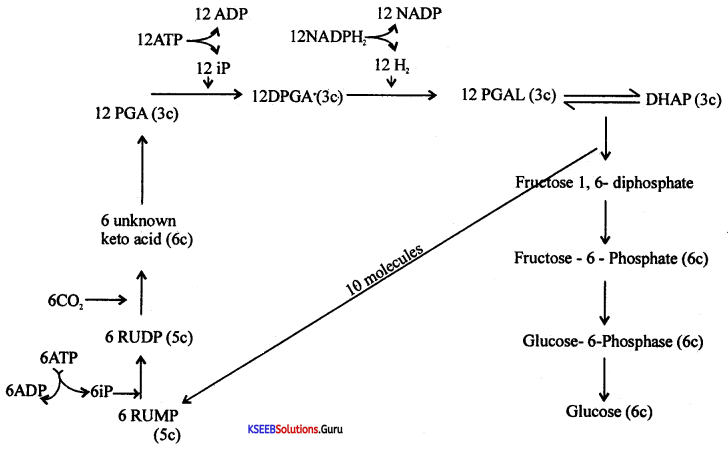Students can Download 1st PUC Biology Previous Year Question Paper March 2017 (North), Karnataka 1st PUC Biology Model Question Papers with Answers helps you to revise the complete Karnataka State Board Syllabus and score more marks in your examinations.
Karnataka 1st PUC Biology Previous Year Question Paper March 2017 (North)
Time: 3.15 Hours
Max Marks: 70
General Instructions:
- The question paper consists of four parts A, B, C, and D.
- All the parts are compulsory.
- Draw diagrams wherever necessary. Unlabelled diagrams or illustrations do not attract any marks.
Part – A
Answer the following questions in one word / one sentence each: ( 10 × 1 = 10 )
Question 1.
Name the modification of leaves for climbing.
Answer:
LeafTendrils.
Question 2.
Give an example of a medicinal plant of the family Solanaceae.
Answer:
Belladonna/ashwagandha.
Question 3.
Name the dense regular connective tissue which attaches the skeletal muscles to bone.
Answer:
Tendons.
Question 4.
What is a telocentric chromosome?
Answer:
A chromosome with a terminal centromere is called a telocentric chromosome.
Question 5.
Why mitosis is called ‘equational division’?
Answer:
Since the number of chromosomes in the parent and progeny cells is the same, mitosis is called equational division.
![]()
Question 6.
Name the phase of Prophase-1 of meiosis during which synapsis takes place.
Answer:
Zygotene.
Question 7.
What are porins?
Answer:
Porins are proteins that form huge pores in the outer membranes of the plastids, mitochondria, and some bacteria allowing molecules up to the size of small proteins to pass through.
Question 8.
The deficiency symptoms of Nitrogen in plants, tend to appear first in the older ‘ tissues, why?
Answer:
Nitrogen is readily mobilized from older dying leaves to younger leaves, thus deficiency symptoms tend to appear first in the older tissues.
Question 9.
What happens when a plant cell is placed in a hypertonic solution to the protoplasm.
Answer:
The protoplasm will shrink away from the walls due to plasmolysis.
Question 10.
Define transamination.
Answer:
It involves the transfer of an amino group from one amino acid to the keto group of a ketoacid.
PART-B
Answer any FIVE of the following questions in 3-5 sentences each, wherever applicable. (5 × 2 = 10)
Question 11.
Name the phases of the life cycle in plants, which alternate with each other.
Answer:
Gametophyte and sporophyte.
![]()
Question 12.
Differentiate chordates from Non-chordates by giving two differences.
Answer:
| Chordata | Non-Chordata |
| (a) Presence of a solid notochord or a vertebral column. | (a) Absence of Chordadorsalis. |
| (b) Presence of a dorsal and tubules nerve chord. | (b) Presence of ventral and solid nervechord. |
| (c) Presence of pharyngeal gillsiits. | (c) Absesnce of gilislits. |
| (d) Presence of ventral heart. | (d) Presence of dorsal heart. |
Question 13.
What is Venation? Mention the types.
Answer:
The arrangement of veins and veinlets in the lamina of the leaf is termed as venation, types :
(a) Reticulate
(b) Parallel.
Question 14.
List the key features of the Metaphase of mitosis.
Answer:
- Spindle fibers attach to kinetochores of chromosomes.
- Chromosomes are moved to the spindle equator and get aligned along with the metaphase plate through spindle fibers to both poles.
Question 15.
What are micronutrients? Name any two of them.
Answer:
Mineral elements required in very small amounts ie, less than 10 mmole kg-1 of dry matter are known as micronutrients, eg: Zinc, copper.
Question 16.
What is biological nitrogen fixation? Give an example each for free-living and symbiotic nitrogen-fixing bacteria.
Answer:
The reduction of nitrogen to ammonia by living organisms is called biological nitrogen fixation.
- Free-living nitrogen-fixing bacteria: A acetobacter.
- Symbiotic nitrogen-fixing bacteria: Rhizobium.
![]()
Question 17.
All the minerals cannot be passively absorbed by the roots give two reasons.
Answer:
All minerals cannot be passively absorbed by the roots as
- Minerals are present in the soil as charged particles (ions) that cannot move across cell membranes.
- The Concentration of minerals in the soil is usually lower than the concentration of minerals in the root.
Question 18.
Differentiate guttation from transpiration.
Answer:
| Transpiration | Guttation |
| 1. Transpiration is a universal phenomenon that occurs in all plants. | 1. Guttation occurs only in herbs, especially in the members of the Milygraminae. |
| 2. It occurs through stomata, cuticles,s, or lenticels. | 2. it occurs through hydathodes or water Stomata. |
| 3. Amount of water lost is enormous. | 3. Water loss is negligible. |
| 4. Transpired water is pure, and is in the form of vapor. | 4. Guttated water contains nitrogenous wastes, amino acids, etc. it is impure and is in the form of droplets. |
PART-C
Answer any FIVE of the following questions in 40-80 words each, wherever applicable: (5 × 3 = 15)
Question 19.
List any six taxonomic categories.
Answer:
Species, Genus, Family, order, class, phylum, kingdom.
Question 20.
Classify the plastids on the basis of pigments.
Answer:
(a) Chloroplasts: Contain more chlorophylls and few carotenoids.
(b) Chromoplasts: Contain carotenoids.
(c) Leucoplasts: Colourless plastids with stored nutrients.
Question 21.
Name the three major types of cells and their secretions of gastric glands.
Answer:
(a) Mucus neck cells: secrete mucus.
(b) Peptic or chief cells: secrete proenzyme pepsinogen.
(c) Parietal or oxyntic cell: secrete HCl and intrinsic factor essential for the absorption of vitamin B12.
Question 22.
Name any three respiratory disorders.
Answer:
Asthma, Emphysema, and occupational respiratory disorders.
![]()
Question 23.
Briefly explain the structure of myosin.
Answer:
Myosin (Thick) Filament: length is about 1.6 nm and breadth the 15nm.
- Myosin is a polymeric protein, whose monomeric proteins are called meromyosins.
- Each meromyosin has two important parts, a globular head with a short arm and a tail.
- The head with the short arm is called the heavy meromyosin (HMM) and the tail is called light meromyosin (LMM).
- The HMM component projects outwards at a regular distance at an angle from the surface of the polymeric meromyosin; it is known as a cross arm.
- The globular head functions as an ATPase enzyme and has the binding sites for ATP and active sites of actin.

Question 24.
List the hormones secreted by the Parsdistalis region of the pituitary.
Answer:
Growth hormone [GH], prolactin [PRL]
Thyroid-stimulating hormone [TSH]
Adreno corticotrophic hormone [ACTH]
Luteinizing hormone [LH]
Follicle-stimulating hormone [FSH],
Question 25.
Which are the organs involved in the regulation of kidney functioning.
Answer:
Hypothalamus, Juxta Glomerulus (diurnal) rhythm of our body.
Question 26.
Mention any three functions of melatonin.
Answer:
- Regulation of a 24 hour (diurnal) rhythm of our body.
- Maintaining the normal rhythms of sleep-wake cycle body temperature.
- Influences metabolism, pigmentation, and menstrual cycle.
Part-D (Section – I).
I. Answer any FOUR of the following questions in 200-250 words each. (4 × 5 = 20)
Question 27.
List any five general characteristics of Pteridophytes.
Answer:
Pteridophytes are characterized by the following features:
1. Their life cycle, comprises a distinct diploid phase represented by a sporophyte and a haploid phase by a gametophyte exhibiting heteromorphic alternation of generations.
2. Sporophyte represents the dominant phase of the life cycle, which is an entirely independent plant body. It bears roots, stems, and leaves. It reproduces asexually by sporangia.
3. The sporangia may be arranged in specific groups called sorus. In a few cases, sporangial structures aggregate on a specialized reproductive structure called strobilus or cone.
4. In sporophyte the vegetative structure shows highly specialized conducting tissues namely xylem and phloem. These tissues are organized into the vascular system called stele.
5. The gametophyte through independence is short-lived. It bears both male and female reproductive structures namely, antheridia and archegonia respectively.
6. Gametophytes thus show Oogamous types of sexual reproduction like Bryophytes. Water is essential for fertilization. The zygote develops into a multicellúlar embryo. Hence, the group is treated under embryophytes Siphonogama (Siphonogama – as it possesses vasculature).
![]()
Question 28.
Write any four salient features of the phylum. Arthropoda and name any two economically important insects.
Answer:
(a) General characters:
1. Arthropods are bilaterally symmetrical, triploblastic, metamerically segmented, and coelomates.
2. Segmentation of the body is less apparent and the number of segments is fewer in number.
3. They show the highest degree of cephalization, that is the formation of a well-developed head. The Head is usually formed by the fusion of six body segments. Following the head, the region is the trunk which is usually divisible into an anterior thorax and a posterior abdomen.
4. Their body segment usually bears paired lateral and jointed appendages. A segment of the appendage is known as podomere. The appendages are variously modified in different groups and even in different parts of the same animal.
- A few appendages close to the mouth are modified into jaws and are helpful in feeding.
- A few appendages are sensory in function
Some appendages help, in locomotion. Due to the presence of jointed appendages or legs for locomotion, the phylum gets the name Arthropoda, which means jointed feet.
(b) Apis (honey bee) and bombyx (silkworm)
Question 29.
Mention any five important characteristics of Prokaryotic cells.
Answer:
- Cell envelop consists of a tightly bound three-layered structure i.e., the outermost glycocalyx followed by the cell wall and then the plasma membrane.
- A special membranous structure is a mesosome that is formed by the extensions of the plasma membrane into the cell.
- The fluid matrix falling from the cell is the cytoplasm.
- There is no well-defined nucleus. The genetic material is basically naked. Many bacteria have small circular DNA outside the genomic DNA called plasmids.
- No organelles except for ribosomes.
- Reserve food material is present in the form of inclusion bodies.
Question 30.
What are ribozymes? Describe the catalytic cycle of enzyme action.
Answer:
Some nucleic acids (RNA) behave like enzymes. These are called ribozymes.
The catalytic cycle of enzyme action can be described in the following steps:
- First, the substrate binds to the active site of the enzyme, fitting into the active site.
- The binding of the substrate induces the enzyme to alter its shape, fitting more tightly around the substrate.
- The active site of the enzyme now in close proximity of the substrate breaks the chemical bonds of the substrate and the new enzyme-product complex is formed.
- The enzyme releases the products of the reaction and the free enzyme is ready to bond to another molecule of the substrate is ready to bond to another molecule of the substrate and run through the catalytic cycle once again.
![]()
Question 31.
Draw a neat labeled diagram of the anatomy of the Dicot leaf.
Answer:

Helianthus lear
Question 32.
Brief explain Calvin cycle with schematic representation.
Answer:
It occurs in the grana of the chloroplast.
It utilizes the assimilatory powers i.e., ATP and NADPH2 produced in 11gm reaction.

Steps:
- Phosphorylation
- Carbon dioxide fixation
- Phosphorylation and reduction.
- Regeneration and RUMP
- Glucose formation.
Note: To complete a Calvin cycle, 18 ATPs and 12 NADPH2 molecules are required.
Section – II
Answer any THREE of the following questions in 200-250 words each, wherever applicable. (5 × 3 = 15)
Question 33.
List any five physiological effects of auxins in plants.
Answer:
Auxins:
- Auxins were the first hormones to be discovered in plants.
- F.W. Went confirmed and isolated the auxins from coleoptiles of Avena saliva.
- Chemically it is called indole-3-Acetic Acid and is derived from amino acid tryptophan.
- Auxins can stimulate cell division, cell elongation, and cell maturation.
- It promotes Apical dominance.
- It initiates Root formation.
- Can promote parthenocarpy.
- Prevent premature fall of flowers, buds, and leaves.
- 2, 4D, and 2, 4, 5T are used as selective weedicides.
- Promote phototrophic and hydrotropic movements.
- Promote xylem differentiation.
Question 34.
Explain the structure of the alimentary canal of Cockroach.
Answer:

![]()
Question 35.
Explain the process of double circulation in humans.
Answer:
Double circulation:
The human heart acts as a double pump.
The right side of the heart receives, and pumps deoxygenated blood and the left side of the heart receives and pumps oxygenated blood and hence both the routes are kept completely separate and there is no mixing of oxygenated and deoxygenated blood. This type of circulation is said to be complete double circulation.
Double circulation involves shorter pulmonary circulation and longer systematic circulation.
Question 36.
(a) Compare aerobic respiration and fermentation.
(b) What is the respiratory quotient? Write the RQ value of carbohydrates.
Answer:
(a) Aerobic respiration: It is a completely oxygen-dependent process, and occurs in the presence of molecular oxygen. It is centered in mitochondria. Here glucose is completely oxidized into CO2 and water. It generates 38 ATP per glucose, and hence a more efficient energy-releasing process. It occurs in the majority of living organisms called aerobes.
C6 H12 O6 + 6O2 → 6CO2 + 6H2O + 686kcal + 38ATP mol
Anaerobic respiration: It is an oxygen-independent procéss and occurs in the absence of oxygen. It is centered in general cytoplasm. Here glucose is incompletely oxidized int0 ethyl alcohol. and CO2 or lactic acid generates only 2 ATPs per glucose molecule and hence less efficient energy-releasing process. It occurs only, in a few orgánisms like bacteria, yeast, etc.
(b) It is defined as the ratio of the volume of CO2 evolved to the volume of O2 utilized.
RQ = \(\frac{\text { Volume of } \mathrm{CO}_{2} \text { released }}{\text { Volume of } \mathrm{O}_{2} \text { utilised }}\)
RQ value for carbohydrates is one.
Question 37.
Draw a neat labeled diagram of a neuron.
Answer:
